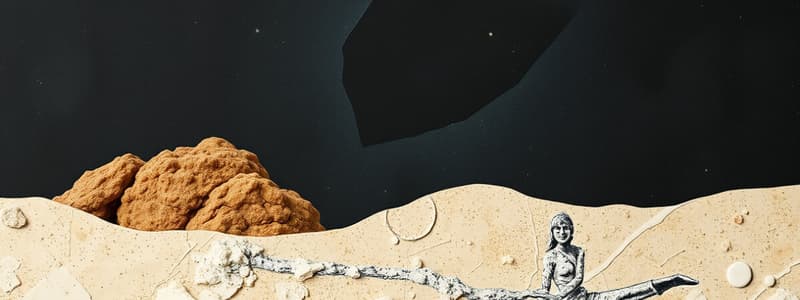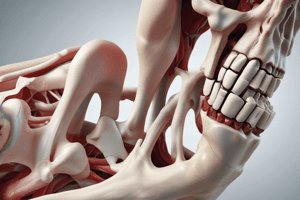Podcast
Questions and Answers
What is calcareous ooze?
What is calcareous ooze?
a fine-grained, deep ocean sediment containing the skeletal remains of calcite-secreting microbes
What is the calcite compensation depth, or CCD?
What is the calcite compensation depth, or CCD?
the ocean depth below which calcite is unstable and will dissolve quickly
What three steps are required for calcareous ooze to exist below the CCD?
What three steps are required for calcareous ooze to exist below the CCD?
deposition of calcite shells above the CCD, cover of these shells by a non-calcareous material, and movement of the sea floor over millions of years
What would happen if the depth of the CCD were above the top of the mid-ocean ridge?
What would happen if the depth of the CCD were above the top of the mid-ocean ridge?
Sediments derived from the remains of once living organisms are called?
Sediments derived from the remains of once living organisms are called?
Two common types of chemical compounds found in biogenous sediments are?
Two common types of chemical compounds found in biogenous sediments are?
The two major types of microscopic planktonic organisms that produce siliceous oozes are?
The two major types of microscopic planktonic organisms that produce siliceous oozes are?
How does siliceous ooze accumulate on the seafloor if silica-based residues are dissolved slowly at all depths?
How does siliceous ooze accumulate on the seafloor if silica-based residues are dissolved slowly at all depths?
Siliceous ooze is particularly abundant on the seafloor at __________ and at __________.
Siliceous ooze is particularly abundant on the seafloor at __________ and at __________.
What is the approximate depth of the calcium compensation depth (CCD) in the ocean?
What is the approximate depth of the calcium compensation depth (CCD) in the ocean?
Forams, which are composed of calcium carbonate, __________ above the CCD and __________ below the CCD.
Forams, which are composed of calcium carbonate, __________ above the CCD and __________ below the CCD.
Diatomaceous earth, which is composed of silica, __________ above the CCD and __________ below the CCD.
Diatomaceous earth, which is composed of silica, __________ above the CCD and __________ below the CCD.
Why does calcareous material dissolve below the CCD?
Why does calcareous material dissolve below the CCD?
Which of the following statements about the CCD is correct?
Which of the following statements about the CCD is correct?
Where is calcareous ooze most likely to be found in surface sediments in the ocean?
Where is calcareous ooze most likely to be found in surface sediments in the ocean?
Which of the following explains why calcareous ooze is sometimes found below the CCD?
Which of the following explains why calcareous ooze is sometimes found below the CCD?
The tests from which of the following organisms will dissolve below the CCD?
The tests from which of the following organisms will dissolve below the CCD?
What is calcareous ooze composed of?
What is calcareous ooze composed of?
Where do calcareous oozes exist on the sea floor?
Where do calcareous oozes exist on the sea floor?
What conditions exist below the CCD?
What conditions exist below the CCD?
Which setting would calcareous ooze be most likely to form?
Which setting would calcareous ooze be most likely to form?
Flashcards are hidden until you start studying
Study Notes
Calcareous Ooze
- Calcareous ooze is fine-grained sediment in deep oceans, composed of skeletal remains from calcite-secreting microbes.
- It contains at least 30% remains of calcareous organisms.
Calcite Compensation Depth (CCD)
- The CCD is the ocean depth where calcite becomes unstable and dissolves quickly.
- Approximately 3 miles (4.5 km) deep, influencing calcareous sediment distribution.
Formation of Calcareous Ooze
- For calcareous ooze to exist below the CCD, three steps are essential:
- Deposition of calcite shells above the CCD.
- Covering of these shells by non-calcareous material.
- Movement of the seafloor over millions of years.
Impact of Mid-Ocean Ridge
- If the CCD rises above the top of the mid-ocean ridge, calcareous ooze would not be found below the CCD.
Biogenous Sediments
- Sediments from previously living organisms are termed biogenous sediments.
- Key chemical compounds in biogenous sediments include calcium carbonate and silica.
Siliceous Oozes
- Siliceous oozes arise from diatoms and radiolarians.
- Silica-based residues accumulate faster than seawater can dissolve them, ensuring accumulation on the seafloor.
Locations of Abundance
- Siliceous ooze is prevalent at high latitudes and equatorial upwelling zones.
Dissolution Characteristics
- Foraminifera do not dissolve above the CCD but dissolve below it.
- Diatomaceous earth does not dissolve at any depth.
- Calcareous material dissolves below the CCD due to weak acid formation from increased carbon dioxide.
Conditions Below CCD
- Below the CCD, conditions include high acidity, cold temperatures, and elevated carbon dioxide concentrations.
Calcareous Ooze Locations
- Calcareous oozes generally exist in relatively shallow areas with warm surface waters.
- They are often found beneath regions where calcareous organisms thrive, but above the CCD.
Seamount Formation
- Calcareous ooze is likely to form on the crest of seamounts where warm surface water is present, facilitating organism proliferation.
Studying That Suits You
Use AI to generate personalized quizzes and flashcards to suit your learning preferences.




